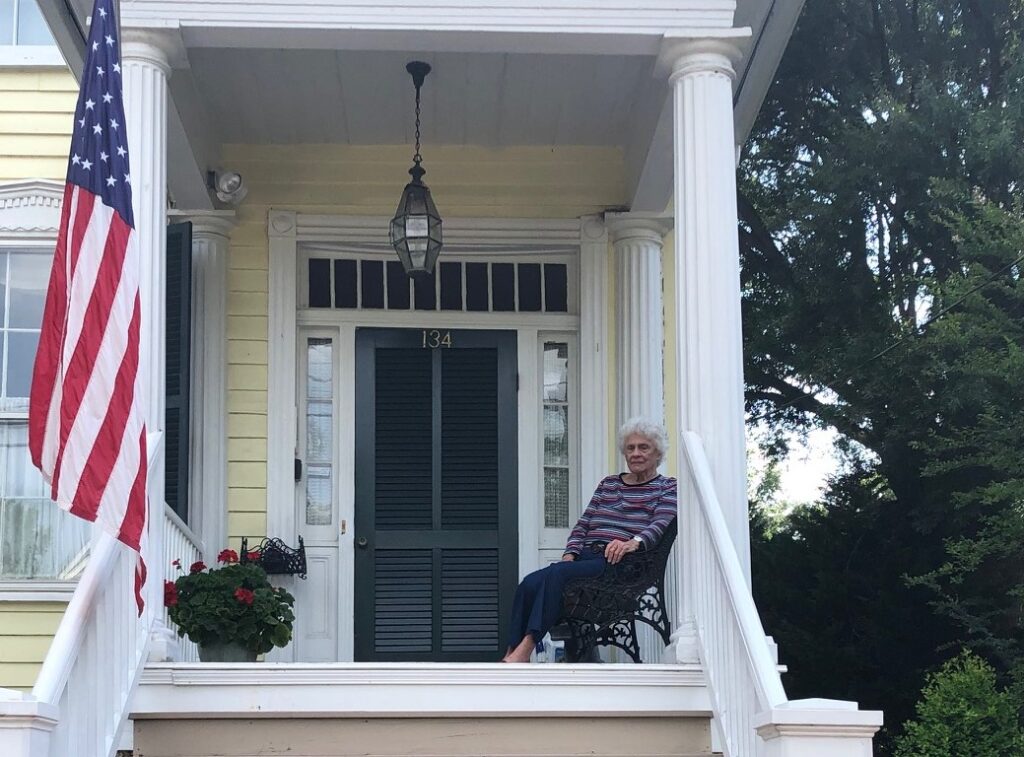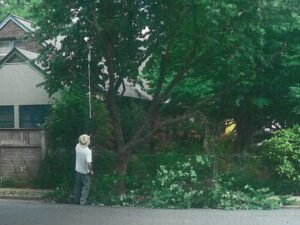
by James A. Bacon
I was driving up Interstate 95 to Fredericksburg one Saturday in April when I got a call from my mother. Pick up a rental chain saw on the way into town, she said. She wanted me to cut down a crape myrtle in front of her house. I knew well the tree she was referring to. She’d planted it as a sprig twelve to fifteen years before, and it had become a nuisance. Branches slapped against the telephone lines overhead, draped over the sidewalk, and shed debris on cars parking in the street. My sister, a housekeeper and I had taken turns pruning it, but the branches quickly grew back. I agreed that it was time to take the wretched thing down for good.
I’m no expert with a chain saw, but it wasn’t a difficult job. I lopped off the branches previously amputated with a hand saw, and carved out chunks of the trunk to chest-high level. Then I attacked the base of the tree, cutting around the rim as deep as the chain saw blade would go. I’d made it about 60% of the way through the trunk when a neighbor approached me in a state of alarm.
Frank Widic was a tree steward with Tree Fredericksburg. I had to immediately stop what I was doing, he told me. The crape myrtle was located on city right-of-way, and I was forbidden by ordinance from cutting it! I protested that the city had done nothing to maintain the tree, and that it needed to come down. That didn’t matter, Widic said. He put me on his cell phone to talk to Anne Little, president of the nonprofit Tree Fredericksburg organization.
Little was even more emphatic. City rules were very clear, she said. I had to stop. If I didn’t, she was obligated to notify the police. Whoah, thought I. This was way above my pay grade. I handed the phone to my mother, who was watching events unfold from a perch on the porch.
Here I must pause to tell you about my mother, Sallie Daiger. She may be 92 years old (she was 91 in April), she may have trouble climbing up and down the stairs, and she may be too timid to drive more than 35 miles per hour, but she manages to live alone without assistance much of the time. (My sister does spend three nights a week with her.) She reads The Wall Street Journal every day, watches Fox Business, and makes astute observations about the debased condition of the world, the nation, the state, and the City of Fredericksburg. Having lived on her own for the past 50 or so years, my mother has learned to stand up for herself. Unscrupulous vendors, tradesmen, and government officials make a big mistake if they take her for a little old lady they can take advantage of. She reads the fine print of contracts and legal documents. She cross-checks numbers in receipts, bills, and credit card statements. No detail is too small. She has held numerous contractors accountable for shoddy workmanship and over-charges, and she has demanded — and received — payment in recompense. Indeed, when she was living in New Zealand a couple of decades ago, she caught her financial adviser cooking the books. She unleashed Kiwi regulatory authorities on him, and he was convicted.
So, when I handed her the phone, and Anne Little told her that I had to cease cutting the tree or she would be have to notify the police, my mother did not respond well. She had planted the crape myrtle herself, and the city had never once acted to maintain it. It was a nuisance, and she took it upon herself to do what the city had failed for years to do. How was she supposed to know there was an obscure page on the city website that said otherwise? If Little wanted to call a policeman to arrest a 92-year-old woman, she said heatedly, go right ahead!
People gathered on the sidewalk in front of the house. Widic was trying to be helpful. Little appeared personally on the scene to reinforce what she had said on the phone. A neighbor began castigating Little for being so belligerent to a 92-year-old woman. A fellow who did landscaping for people along the street came to see what was happening. He’d been trimming a tree earlier that week, he chimed in, and the City told him to stop as well. Curious neighbors espied developments from a distance.
Things finally calmed down when Little informed me that the City of Fredericksburg would finish taking down the crape myrtle and would grind out the stump as well. There was little cutting left to do and I had no means of removing the stump, so I was delighted to turn the rest of the job over to others. I told my mother that the city would take care of the rest, and that was good enough for me. That sounded agreeable to her. With the issue seemingly resolved, everyone dispersed
If the incident had ended there, there would be nothing to write about. Needless to say, there is more to the story.
*****

On April 21 Diane Beyer, Fredericksburg’s director of public works and city arborist, appeared at my mother’s front door in the company of a uniformed police officer, Joe Young. She hand-delivered a letter, which stated, “It has come to our attention that one of the mature crape myrtles in the utility strip in front of [my mother’s house] was cut down.” Trees on city utility strips were to be maintained by trained city-designated personnel only. The “high” trunk I had left behind created a “hazard” that required removal by the city. The charge for the work was $386.86. Moreover, the city was billing $787 to replace the tree, with a year of new-tree care also at my mother’s expense. The total due the city was $1,117.86.
Here was the kicker. “This action,” the letter said, “is being taken in lieu of civil or criminal prosecution.”
My mother, who was having a late breakfast when Beyer arrived, did not receive this news well. Beyer was neither impolite nor belligerent, but she had taken my mother totally by surprise. Moreover, my mother had been admitted to the hospital the week before for chest pains (which, fortunately, turned out not to be a heart attack) and was aching from a bad tooth (which was subsequently pulled out), and she was not her usual combative self. Nearly one thousand, two-hundred dollars seemed like a lot of money to finish the job of cutting down the tree, but she was too stunned to argue much.
After explaining the contents of the letter, Beyer departed. Young, the city watershed manager stayed behind. My mother was crying. Young was very polite, even sweet, she recalls. But that didn’t stop him from leaving her a hand-written note that reiterated the situation she faced. It said:
Could happen
summons
court
fine
restitution
My mother remembers commenting upon the weapons and equipment dangling from his torso. “He looked like he was going into battle,” she recalls. She asked why he had brought weapons into her house. He did not answer. But he did provide his phone number and said to call him any time.
*****
None of this made any sense to my mother, my sister (who was inevitably dragged into the affair), or me. The bill seemed absurdly high.
I called Beyer at her office to ask how she could justify such a figure. I’ll give her credit for getting back to me promptly and speaking courteously. She explained that there are thousands of trees in city rights-of-way, and the city has enacted policies regarding which species are permitted, how far trees must be planted from utility poles and other trees, and how the city (or the tree wardens with Tree Fredericksburg) was responsible for their maintenance, along with other guidelines. The multi-stemmed crape myrtle that I had been cutting down was no longer permitted. Technically, she said, it was not even a tree. It was a profusely growing shrub. If the crape myrtle was no longer permissible and was a nuisance, I asked, why hadn’t the city removed it previously?
“I can’t speak to that,” she said.
Beyer did say a couple of things, however, that made me wonder about her command of the details. For example, she mentioned that, in recognition of her advanced age, my mother was allowed to leave garbage bags for pick-up at the top of the front stairs. She was “the only person in the city we do that for,” Beyer said. It is true that my mother is not required to drag her trashcan to the curb, as is standard practice, but she does not leave her bags at the top of the steps. She leaves them at the bottom of the steps — requiring the garbagemen to walk only a few extra paces to pick them up.
Beyer also told me that her tree crew had seen me cutting down the tree and told me to stop, but that I hadn’t. I told her that was flat-out wrong. Frank Widic, the tree warden, had told me to stop. Which I did. As far as I knew, the city crew had made no appearance that day. Beyer said she was glad to stand corrected.
(Additionally, in her personal conversation with my mother, Beyer contradicted my mother’s statement that she had planted the crape myrtle as well as a single-stem crape myrtle some distance away. The City, Beyer said, had a record of having planted the trees. Yet she could not possibly have any such record. My mother remembers distinctly planting them from sprouts in her back yard.)
At a point in the conversation, Beyer noticed the furious clicking of my keyboard. During their encounter, my mother had uttered her words to the effect that, “My son publishes a blog, and I’m sure he’d be very interested to write about this.” Beyer said she would end the conversation unless I stopped taking notes. I agreed to continue the chat off the record, so I am not at liberty to share any other details. In closing the conversation, she agreed to send me an itemized breakdown of the charges.
The itemization arrived by email a few days later. The spreadsheet contained more red flags than a capture-the-flag tournament.
Beyer wanted to charge my mother $386.86 for completing the removal of the tree. To accomplish the last few minutes of sawing the trunk and hauling away several two- to three-foot logs, she wanted to bill for the work of four city laborers, working two hours each, riding in two trucks and toting a stump grinder. Really? Four city employees? Let’s put it this way: If it took four employees two hours to complete the task I had mostly finished in half an hour, the City of Fredericksburg public works department has some major productivity issues that need attending to!
(Adding to the absurdity of the bill, when the city did get around to removing the tree trunk several days later, the crew did not grind the stump. Beyer billed my mother $70 for a stump grinder that was never used!)
She wanted to charge $787 to plant a single-stem crape myrtle. That included $187 for the tree, plus $300 for “freight” from an out-of-town nursery, $200 for planting, and $100 for a year’s watering.
 Needless to say, we immediately hopped on the Internet to see what the private sector would charge. The cost of a white Natchez crape myrtle (permissible under the city tree guidelines) in the Fredericksburg area ranged between $20 and $90. Home Depot advertised a white Natchez for $41.46 — and that included free delivery!
Needless to say, we immediately hopped on the Internet to see what the private sector would charge. The cost of a white Natchez crape myrtle (permissible under the city tree guidelines) in the Fredericksburg area ranged between $20 and $90. Home Depot advertised a white Natchez for $41.46 — and that included free delivery!
Now our hackles were really up. From our perspective, it looked like Beyer had not only dragooned a police officer into intimidating my elderly mother with the threat of civil or criminal prosecution, the public works director had stuck her with a grossly inflated bill. Is that how Fredericksburg treated its tax-paying citizens?
*****
That’s when I decided to start filing Freedom of Information Act requests. If the public works department had tried to shake down my elderly mother, perhaps it had done the same to others. First, I queried the Fredericksburg Police Department, asking about its policy regarding police officers accompanying city officials for the purpose of bill collection. I also sought documentation of instances in which police officers had gone on such calls.
I received an answer from Captain Betsy Mason, detective division commander, who handles FPD’s FOIA requests. “It is not the practice of the Fredericksburg Police department to accompany employees of the Department of Public works to deliver letters demanding payment of charges for services,” she wrote. “There is no policy on this specific issue.”
Law enforcement assists city officials if specifically called upon, and such instances would be recorded as a call for service, Mason wrote. “This is not a regular practice therefore I do not know of any specific incidents where this has occurred.”
We later connected by phone. Mason confirmed that Young was a “sworn police officer” with the FPD and that, as city watershed manager, he was assigned to work with Beyer. When I explained their encounter with my mother, she said that the incident was “unusual” enough that she would bring it to the police chief’s attention. She called back the next day to say the chief was “addressing” the issue. Delivering letters demanding payment “is not something we want to associate ourselves with.”
Through another FOIA request, I also uncovered correspondence between Beyer and/or her predecessor between 2019 and 2021 regarding the removal of trees and vegetation. Several incidents were directly comparable to ours in that they involved the removal or severe pruning of trees in city-owned right of way. The outcomes varied widely.

One incident involved Preston Thayer, a resident of Prince Edward Street, whom city staff had encountered trimming a tree in the utility strip. Utility strips, Beyer informed Thayer in a letter, are city property and to be cared for only by city-certified arborists or city-designated trained personnel. “Citizens are not authorized to trim, or otherwise alter, street trees,” she wrote. Offenses are punishable by fines up to $1,000, plus civil penalties and charges. However, she did not charge him for damage to the tree.
Another episode involved an unnamed resident of Willis Street. The City had discovered that a tree in the utility strip had been “severely and improperly pruned.” Proper pruning is important because trees in utility strips have restricted root areas and must have their canopies managed to prevent obstruction of sidewalks, parking lanes, and utility lines, Beyer explained in a letter. She told the resident to “please refrain from or keep others from manipulating utility strip trees in any way.”
In yet another encounter, a City employee informed Daniel Khadduri, a resident of Amelia Street, that a tree in the utility strip had been “severely and improperly pruned” in violation of city code. The tree was so damaged that it had been replaced. To avoid having a lien placed against his property, Beyer instructed, Khadurri should send a $250 check to the City.
Similarly, Kimberly Alexander, special projects manager for Public Works, emailed a “Ms. O’Grady” in follow-up to a telephone conversation regarding unpermitted work on a cherry tree on Princess Ann Street. The city arborist (presumably Beyer) had assessed the damage and determined that if the damage didn’t kill the tree, the extensive pruning required to remove the damage certainly would. The city charged Ms. O’Grady $256.46 for removal and another $300 for tree replacement, for a total of $557.46. In parentheses, the letter noted that the new tree “may or may not be re-planted in the same location.”
Notably, an attached spreadsheet indicated that Beyer was charging Ms. O’Grady for the labor of four men working only one hour each — not two hours as she had charged my mother.
Lastly, there was an instance that nearly led to criminal charges. Paul Janney, a local real estate agent and developer, had purchased a house on Lee Street. As part of his plans for the property, he needed a separate driveway, which necessitated making a curb cut and cutting down a willow oak tree. The city approved the request and issued a permit, but Janney made one mistake. He cut down the tree before the permit was formally issued. The city initially demanded $15,000 recompense. The city attorney wrote a letter threatening criminal charges. Janney negotiated the charge down to $2,750 for the loss of the large oak and another $2,750 to cover the cost of planting, watering, and pruning eleven caliper trees to replace the oak. The logic was that the eleven smaller trees would provide comparable tree cover to the giant oak the city was deprived of. As a developer, Janney didn’t want to go to war with the city, so he agreed to pay the $5,500.
The revelation from these FOIA documents is that the city is inconsistent in the way it treats people. One resident was warned about his severe pruning but not fined, while another resident was charged $250, and another charged $557. One resident was charged for one hour’s labor for four workers, while another (my mother) was charged for two hours. Janney, who had acted with what he thought was the city’s permission, was charged $15,000 initially, but after hiring a lawyer (according to the letter of agreement) he bargained the fee down to $5,500.
But wait, that’s the least of it.
*****
On its website, the City of Fredericksburg has posted a document, “Guidelines for Street Tree Planting.” The goal of city street planting, says the document, is “Right Tree – Right Place.” The city aims for a diversity of species, giving preference to native tree species. It emphasizes that “multi-stem trees and shrubs” — like the crape myrtle I was trying to remove — “shall not be planted in city utility strips. Only single stem Crape Myrtles can be planted when there is no other alternative.” (The bold face appears in the document.)
The guidelines list minimum clearance distances from the tree to be planted and various other objects such as water meters, utility polls, fire hydrants, traffic signs, and other trees. Most noteworthy in my mother’s case, trees must be located “every 25-30 feet along the street” and cannot be planted within 10 feet of a utility pole.
I mentioned that my mother has a keen eye for detail. After reading this document, she measured the distance between the tree stump, a nearby utility pole, and the nearest trees in the utility strip. Due to the presence of the utility pole and other trees, it was impossible to plant a new tree and comply with the city’s guidelines!
In other words, Beyer threatened my mother with civil or criminal prosecution if she failed to pay $787 to plant a tree that violated the city’s own published guidelines! Evidently, she hadn’t even bothered to make the measurements!
In our conversations amongst ourselves, my mother, sister and I conceded that we had violated the new 2019 ordinance by cutting down the tree. The original planting might have been legal — done before the city enacted its tree ordinances — but the law was clear that only the city was allowed to take it down. Still, the idea of charging an inflated price to plant a tree in violation of the city guidelines struck us as ludicrous. The City of Fredericksburg provides no avenue of appeal for such a decision. I wrote City Manager Timothy Baroody and asked him to review the case but never heard back from him.
We did hear back from Beyer, however. In a letter dated June 24, 2021, she backed off her original demand that my mother pay $1,173.86. But she still charged $147.86 to cover the cost of dispatching a two-man crew for two hours of work. Further, she billed $450 to replace the crape myrtle. The total came to $597.86.
Beyer never apologized for her original, inflated bill. Implicitly acknowledging that it was impossible to plant a new tree in front of my mother’s house without violating city guidelines, she wrote, “We will mitigate the removal of this tree by planting another young tree close by.”
By what possible reasoning does the city demand payment for replacing a tree that it did not plant, it never maintained, it no longer permits, and was removed from a location where no other tree is allowed to be planted.”
In consideration of Beyers’ bullying and intimidation, the outrageous padding of the original bill, and the unjustifiable nature of the second bill, I wrote back on behalf of my mother: “Mrs. Daiger refuses to pay the City of Fredericksburg one cent toward either the removal or replacement of the crape myrtle tree.”

Leave a Reply
You must be logged in to post a comment.